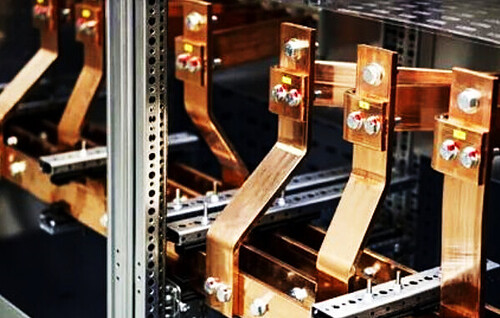What is the primary purpose of applying a coating to copper busbars in electrical panels or busducts?
The major objective of adding a coating on copper busbars in the electrical panels (or) busducts is to prevent oxidation & corrosion which helps to maintain low electrical resistance at connection points & assures the electrical system’s long-term stability.
Important Reasons for covering Copper Busbars
Corrosion Prevention: Over time, copper generates an oxide layer, which increases contact resistance and causes joint overheating. Coating protects against this.
Improved Electrical Conductivity: A clean, shielded surface allows for improved current flow with less energy loss.
Enhanced Mechanical Protection: The coating lowers wear and tear caused by vibration, moisture & environmental causes.
Safety: Some coatings give greater insulation, lowering the possibility of an inadvertent short circuit.
Aesthetics & Identification: Coating can also aid with color coding in panels to identify phases.
- Tin plating,
- Silver plating,
- Nickel plating &
- Insulating varnish
are all common coatings that depend on the application and atmospheric conditions.
Comparsion
| Coating Type | Primary Purpose | Advantages | Disadvantages | Typical Applications |
|---|---|---|---|---|
| Tin Plating | Reduces the risk of oxidation and corrosion | Economically rational. An excellent resistance to corrosion. Preserves a low electrical contact resistanceSurface that can be soldered | Because it is a softer metal, it might wear out over time.Not suitable for temperatures that are really high | Switchboards, busducts, LV/MV panels & interior substations. |
| Silver Plating | Exceptional conductivity and protection against corrosion | Conductivity of electricity that is the highest among all metals. Exceptional for drops of high current and low voltage when used. Unaffected by oxidation in the majority of settings used | Quite pricey. In conditions that are high in sulfur, it may tarnish. | Important industrial systems, power plants, and high-voltage switchgear |
| Nickel Plating | Protection against corrosion and wear | Extremely hard surface. Excellent in settings that are both corrosive and high in temperature. Lasts for a long time and protects against unintentional short circuits. | It is more expensive than tin. The conductivity is slightly lower than that of copper. | Dangerous workplaces, chemical factories, and maritime uses |
| Epoxy/Insulating Varnish | Insulating electrical systems and protecting against corrosion | A barrier against moisture; the ability to color code | It is not possible to use it on touch surfaces. Thermal conductivity that is restricted. | Components such as covered busbars, compact busducts, and phase separation |
| Bare Polished Copper (No Coating) | (polished for the initial conductivity) The answer is none. | The highest possible conductivity initially. A low cost | Rapid oxidation occurs. There is a greater demand for maintenance. | Indoor dry environments & temporary systems & settings: |
You can also follow us on AutomationForum.co, Facebook and Linkedin to receive daily Instrumentation updates.
You can also follow us on ForumElectrical.com , Facebook and Linkedin to receive daily Electrical updates.
